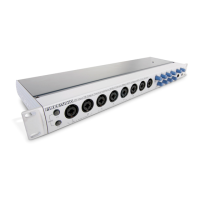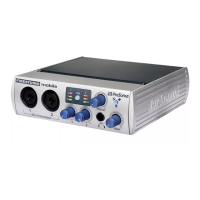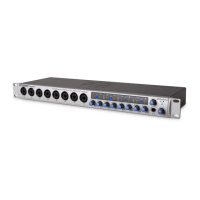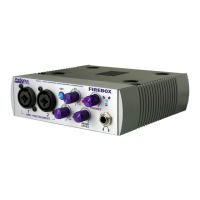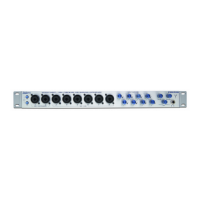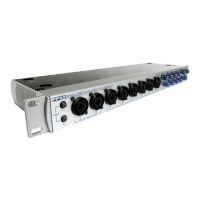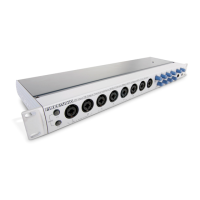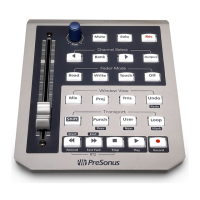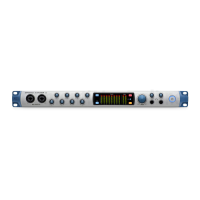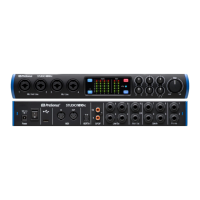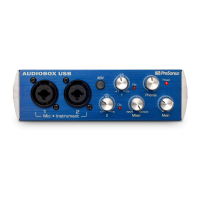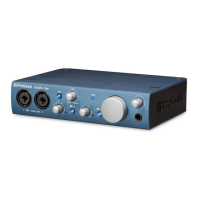Do you have a question about the PRESONUS FIRESTATION and is the answer not in the manual?
Information regarding the FIREstation's role as an audio interface and support for computer-based recording.
Detailed steps for installing drivers and connecting the FIREstation to your computer.
Explanation of using headphone and main outputs for monitoring during recording sessions.
Overview of the two different mix modes: Internal and External, and their benefits.
Describes using software and internal plugins for mixing, utilizing master outputs and headphones.
Explains incorporating external equipment for processing and routing master outputs back to the FIREstation.
Using the FIREstation as an ADAT line mixer and A/D, D/A converter without a computer.
Guidance for using the FIREstation in ADAT special mode with DigiDesign 001.
Operating the FIREstation as an ADAT line mixer or converter with analog inputs non-functional.
Details on the two preamps, switchable between solid-state and tube drive with gain and drive controls.
Explanation of the onboard line mixer that eliminates monitoring delay for all channels.
Description of the dual concentric knob controlling headphone and master output volumes.
Information on BNC Word Clock connectors and MIDI I/O for synchronization and control.
Details on the mLAN protocol for connecting and sharing information with digital devices.
Information on the footswitch input for controlling recording start/stop, and its separate purchase requirement.
Explanation of the MIDI I/O for connection with external MIDI equipment, programming, MMC, and MTC.
Details on the ADAT I/O for interconnectivity with ADAT devices, supporting up to eight channels.
Information on the S/PDIF I/O for transferring/receiving audio from other digital audio devices.
Explanation of the BNC I/O for syncing frame rates with other digital devices to prevent audio artifacts.
Details on the switchable preamps, including tube drive, gain, and saturation controls.
Description of the Neutrik combo connector inputs accepting XLR or 1/4" instrument signals.
Explanation of input meters indicating signal strength and clip indicator lights.
Information about the +48 volt phantom power switch required for condenser microphones.
Details on the -20 dB pad to accommodate higher level signals, useful with phantom powered microphones.
Description of the line mixer routing all channels to headphone/main outputs with dual concentric knobs.
Details on volume and panning controls for individual channels and stereo pairs in the line mixer.
Explanation of the mLAN return controls for channels assigned by the computer, and computer-dictated panning.
Details on clock control for digital stability, including internal (INT) and external (EXT) modes.
Description of independent volume controls for headphone and main outputs, influenced by line mixer settings.
Explanation of the MIXER button that engages the line mixer, affecting mLAN return channels.
Details on the S/PDIF button switching channels seven and eight to accept S/PDIF input.
Explanation of the ADAT button assigning ADAT input to the line mixer and TRS outputs, mirroring ADAT input.
Description of the ADAT to mLAN button routing ADAT input to the mLAN output to the computer.
Details on the S/PDIF to mLAN button activating S/PDIF input and routing it to the computer.
Overview of clock modes: EXT, BNC, mLAN, and ADAT for external device synchronization.
Explanation of EXT mode where Word Clock is set by an external device, using BNC, mLAN, or ADAT controllers.
Details on using the BNC input/output for syncing with other digital devices via Word Clock.
Information on mLAN as a common clock mode, allowing the computer to be the master clock.
Description of ADAT mode for slaving FIREstation to an external device via ADAT optical output.
Information on internal clock modes with available sample rates: 32k, 44.1k, and 48k.
Notes on button behavior for EXT clock and sample rate LED blinking indicators.
Details on the IEC power connector and voltage compatibility check before plugging in.
Information on the power switch and recommendation to power off between uses.
Description of the bidirectional 6-pin FireWire ports for connecting to other devices.
Details on the breakout cable for MIDI I/O and S/PDIF coaxial input, noting it doesn't support optical without a converter.
Illustrates an example of daisy-chaining MIDI devices like drum machines and keyboards.
Information on ADAT I/O for interconnectivity, supporting eight channels of audio up to 24-bit/48k.
Explanation of the BNC I/O for syncing frame rates with digital devices to prevent audio issues.
Details on the footswitch input for recording control and its separate purchase requirement.
Description of TRS balanced/unbalanced inputs and outputs for connecting audio gear and external processors.
Information on TRS sends for direct preamp outputs to connect external dynamics processors.
Details on the Main Outs designed for Control Room Monitors, with content and volume dictated by the line mixer.
Explanation of adjusting the OdB reference level to match external analog devices for proper meter readings.
Information on the unit's heat vents and the importance of adequate rack space for cooling.
Details on supported operating systems (Windows XP, Macintosh OS 9.x) and unsupported ones.
Information on ASIO and WDM drivers for recording/playback and using the Yamaha mLAN control panel.
Clarification that ADAT I/O does not support optical S/PDIF, which uses two channels and coaxial plugs.
Explanation of audio artifacts caused by Word Clock discrepancies and how to align digital devices.
Note that ADAT I/O cannot be used simultaneously with Line or S/PDIF I/O, but ADAT inputs can mirror Line outputs.
Explanation that tube drive and gain can increase noise floor, but offer sonic possibilities.
Information that mLAN returns three and four are unusable in ADAT or standalone mode, requiring routing to channels one and two.
Guidance on resolving pops, clicks, or distortion by ensuring correct Word Clock sync with a master/slave configuration.
Troubleshooting steps for MIDI I/O issues, including cable checks, channel settings, and patch bay configuration.
Details on the footswitch operation channel and controller values.
Information on addressing doubling effects or extreme delay by adjusting monitoring setup or computer performance.
Guidance on driver recognition issues, ASIO for multi-channel, and WDM for stereo use only.
Confirmation of supported operating systems (Windows XP, Macintosh OS 9.x) and unsupported ones.
Note that non-Presonus FireWire/mLAN devices are not covered by warranty or support.
Explanation that the line mixer does not contain analog signals when FIREstation is used as an A-D converter.
Indicates no clock is present for the FIREstation to be slaved to the external device when EXT button blinks.
Signifies signal is out of the sampling range when the Sample Rate/external device LED blinks.
Warning about creating a feedback loop by connecting S/PDIF input to output, resulting in strange audio.
Information regarding the FIREstation's role as an audio interface and support for computer-based recording.
Detailed steps for installing drivers and connecting the FIREstation to your computer.
Explanation of using headphone and main outputs for monitoring during recording sessions.
Overview of the two different mix modes: Internal and External, and their benefits.
Describes using software and internal plugins for mixing, utilizing master outputs and headphones.
Explains incorporating external equipment for processing and routing master outputs back to the FIREstation.
Using the FIREstation as an ADAT line mixer and A/D, D/A converter without a computer.
Guidance for using the FIREstation in ADAT special mode with DigiDesign 001.
Operating the FIREstation as an ADAT line mixer or converter with analog inputs non-functional.
Details on the two preamps, switchable between solid-state and tube drive with gain and drive controls.
Explanation of the onboard line mixer that eliminates monitoring delay for all channels.
Description of the dual concentric knob controlling headphone and master output volumes.
Information on BNC Word Clock connectors and MIDI I/O for synchronization and control.
Details on the mLAN protocol for connecting and sharing information with digital devices.
Information on the footswitch input for controlling recording start/stop, and its separate purchase requirement.
Explanation of the MIDI I/O for connection with external MIDI equipment, programming, MMC, and MTC.
Details on the ADAT I/O for interconnectivity with ADAT devices, supporting up to eight channels.
Information on the S/PDIF I/O for transferring/receiving audio from other digital audio devices.
Explanation of the BNC I/O for syncing frame rates with other digital devices to prevent audio artifacts.
Details on the switchable preamps, including tube drive, gain, and saturation controls.
Description of the Neutrik combo connector inputs accepting XLR or 1/4" instrument signals.
Explanation of input meters indicating signal strength and clip indicator lights.
Information about the +48 volt phantom power switch required for condenser microphones.
Details on the -20 dB pad to accommodate higher level signals, useful with phantom powered microphones.
Description of the line mixer routing all channels to headphone/main outputs with dual concentric knobs.
Details on volume and panning controls for individual channels and stereo pairs in the line mixer.
Explanation of the mLAN return controls for channels assigned by the computer, and computer-dictated panning.
Details on clock control for digital stability, including internal (INT) and external (EXT) modes.
Description of independent volume controls for headphone and main outputs, influenced by line mixer settings.
Explanation of the MIXER button that engages the line mixer, affecting mLAN return channels.
Details on the S/PDIF button switching channels seven and eight to accept S/PDIF input.
Explanation of the ADAT button assigning ADAT input to the line mixer and TRS outputs, mirroring ADAT input.
Description of the ADAT to mLAN button routing ADAT input to the mLAN output to the computer.
Details on the S/PDIF to mLAN button activating S/PDIF input and routing it to the computer.
Overview of clock modes: EXT, BNC, mLAN, and ADAT for external device synchronization.
Explanation of EXT mode where Word Clock is set by an external device, using BNC, mLAN, or ADAT controllers.
Details on using the BNC input/output for syncing with other digital devices via Word Clock.
Information on mLAN as a common clock mode, allowing the computer to be the master clock.
Description of ADAT mode for slaving FIREstation to an external device via ADAT optical output.
Information on internal clock modes with available sample rates: 32k, 44.1k, and 48k.
Notes on button behavior for EXT clock and sample rate LED blinking indicators.
Details on the IEC power connector and voltage compatibility check before plugging in.
Information on the power switch and recommendation to power off between uses.
Description of the bidirectional 6-pin FireWire ports for connecting to other devices.
Details on the breakout cable for MIDI I/O and S/PDIF coaxial input, noting it doesn't support optical without a converter.
Illustrates an example of daisy-chaining MIDI devices like drum machines and keyboards.
Information on ADAT I/O for interconnectivity, supporting eight channels of audio up to 24-bit/48k.
Explanation of the BNC I/O for syncing frame rates with digital devices to prevent audio issues.
Details on the footswitch input for recording control and its separate purchase requirement.
Description of TRS balanced/unbalanced inputs and outputs for connecting audio gear and external processors.
Information on TRS sends for direct preamp outputs to connect external dynamics processors.
Details on the Main Outs designed for Control Room Monitors, with content and volume dictated by the line mixer.
Explanation of adjusting the OdB reference level to match external analog devices for proper meter readings.
Information on the unit's heat vents and the importance of adequate rack space for cooling.
Details on supported operating systems (Windows XP, Macintosh OS 9.x) and unsupported ones.
Information on ASIO and WDM drivers for recording/playback and using the Yamaha mLAN control panel.
Clarification that ADAT I/O does not support optical S/PDIF, which uses two channels and coaxial plugs.
Explanation of audio artifacts caused by Word Clock discrepancies and how to align digital devices.
Note that ADAT I/O cannot be used simultaneously with Line or S/PDIF I/O, but ADAT inputs can mirror Line outputs.
Explanation that tube drive and gain can increase noise floor, but offer sonic possibilities.
Information that mLAN returns three and four are unusable in ADAT or standalone mode, requiring routing to channels one and two.
Guidance on resolving pops, clicks, or distortion by ensuring correct Word Clock sync with a master/slave configuration.
Troubleshooting steps for MIDI I/O issues, including cable checks, channel settings, and patch bay configuration.
Details on the footswitch operation channel and controller values.
Information on addressing doubling effects or extreme delay by adjusting monitoring setup or computer performance.
Guidance on driver recognition issues, ASIO for multi-channel, and WDM for stereo use only.
Confirmation of supported operating systems (Windows XP, Macintosh OS 9.x) and unsupported ones.
Note that non-Presonus FireWire/mLAN devices are not covered by warranty or support.
Explanation that the line mixer does not contain analog signals when FIREstation is used as an A-D converter.
Indicates no clock is present for the FIREstation to be slaved to the external device when EXT button blinks.
Signifies signal is out of the sampling range when the Sample Rate/external device LED blinks.
Warning about creating a feedback loop by connecting S/PDIF input to output, resulting in strange audio.
| Brand | PRESONUS |
|---|---|
| Model | FIRESTATION |
| Category | Recording Equipment |
| Language | English |
